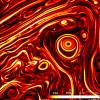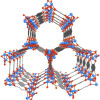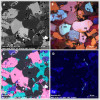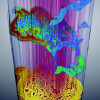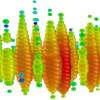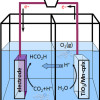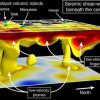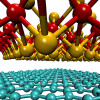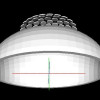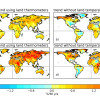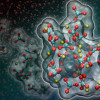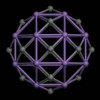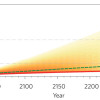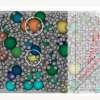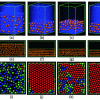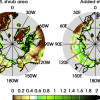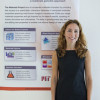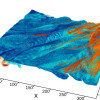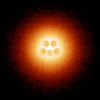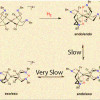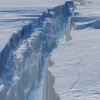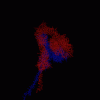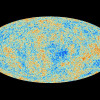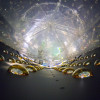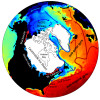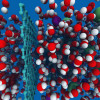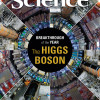Science News
Supercomputers Capture Turbulence in the Solar Wind
With help from Berkeley Lab's visualization experts and NERSC supercomputers, astrophysicists can now study turbulence in unprecedented detail, and the results may hold clues about some of the processes that lead to destructive space weather events. Read More »
An Inside Look at a MOF in Action
A unique inside look at the electronic structure of a highly touted metal-organic framework (MOF) as it is adsorbing carbon dioxide gas should help in the design of new and improved MOFs for carbon capture and storage. Read More »
NERSC Supercomputers Help Reveal Secrets of Natural Gas Reserves
Supercomputers at the Department of Energy’s National Energy Research Supercomputing Center (NERSC) helped scientists at Oak Ridge National Laboratory (ORNL) study gas and oil deposits in shale and reveal structural information that could lead to more efficient extraction of gas and oil from shale. Read More »
Big Data Hits the Beamline
When scientists from around the world visit Dula Parkinson’s microtomography beamline at Lawrence Berkeley National Laboratory’s Advanced Light Source, they all want the same thing: scientifically illuminating X-ray views of matter. Unfortunately, many of them have left with debilitating data overload. Department of Energy scientists like Parkinson are collaborating with computational scientists and mathematicians on data-handling and analysis tools. Read More »
Searching for Cosmic Accelerators via IceCube
New results from IceCube, the neutrino observatory buried at the South Pole, may show the way to locating and identifying cosmic accelerators in our galaxy that are 40 million times more powerful than the Large Hadron Collider at CERN. Read More »
Greenhouse Gases into Gold
Environmentalists have long lamented the destructive effects of greenhouse gases, with carbon dioxide (CO2) often accused of being the primary instigator of global climate change. As a result, numerous efforts are under way to find ways to prevent, capture and sequester—perhaps even bury—CO2 emissions and reduce their negative effects. But some researchers say CO2 is getting a bad rap. Read More »
New Model of Earth’s Interior Reveals Clues to Hotspot Volcanoes
Using supercomputers at NERSC, scientists have detected previously unknown channels of slow-moving seismic waves in Earth’s upper mantle. This discovery helps to explain how “hotspot volcanoes”—the kind that give birth to island chains like Hawaii and Tahiti—come to exist.
Read More »
2D Monolayers Could Yield Thinnest Solar Cells Ever
New computer simulations have shown how using a different type of material could enable thinner, more lightweight solar panels that provide power densities – watts per kilogram of material – orders of magnitude higher than current technologies. Read More »
Clot Busting Simulations Test Potential Stroke Treatment
Researchers are using computer simulations to investigate how ultrasound and tiny bubbles injected into the bloodstream might break up blood clots, limiting the damage caused by a stroke in its first hours. Read More »
NERSC Calculations Provide Independent Confirmation of Global Land Warming Since 1901
Scientists report that land surface air temperatures estimated using a number of historical observations largely match the existing temperature measurements spanning the years 1901 to 2010. Read More »
OpenMSI: A Science Gateway to Sort Through Bio-Imaging’s Big Datasets
MSI technology is already helping doctors to better diagnose diseases, and leading to the creation of energy efficient and renewable biofuels. But researchers envision these areas of science progressing much faster—if only they had the computational tools to easily process, analyze and share these massive datasets. Now, they do—it’s called OpenMSI. Read More »
Computer Simulations Indicate Calcium Carbonate Has a Dense Liquid Phase
Berkeley Lab researchers find that calcium carbonate – the ubiquitous compound that is a major component of seashells, limestone, concrete, antacids, and myriad other naturally and industrially produced substances – may momentarily exist in liquid form as it crystallizes from solution. Read More »
NERSC Helps Physicists ID New Molecules With Unique Features
Hollow magnetic cage molecules may have applications in technology, healthcare Read More »
Rising Sea Levels Due to Global Warming Are Unstoppable
A reduction in greenhouse gas emissions could greatly lessen the impacts of climate change. However, the gases already added to the atmosphere ensure a certain amount of sea level rise to come, even if future emissions are reduced. A study by National Center for Atmospheric Research (NCAR) scientist Gerald Meehl and colleagues quantifies the impact on oceans of the “climate commitment” being made now by human activity. Read More »
Throwing a Lifeline to Scientists Drowning in Data
Computational scientists at Berkeley Lab have figured out how to streamline the analysis of enormous scientific datasets. The analysis uses the same techniques that make complex subway systems understandable at a glance. Read More »
Physics of Intrinsic Plasma Rotation Explained for First Time
The quality of a fusion reaction is determined by plasma confinement at the edge, which is not yet completely understood due to the complicated interactions between multiscale physics. The SciDAC-developed XGC1 code, which was created using NERSC supercomputers, is the world’s first and only gyrokinetic code able to simulate the multiscale turbulence and background physics in realistic edge geometries. Read More »
With Nanoparticles, Slower May Be Better
Molecular dynamics simulations conducted at NERSC provide unprecedented understanding of nanoparticle structure and symmetry. Read More »
Thriving Tundra Bushes Add Fuel to Northern Thaw
Carbon-gobbling plants are normally allies in the fight to slow climate change, but in the frozen north, the effects of thriving vegetation may actually push temperatures higher. In a series of climate simulations performed at NERSC, a group of researchers found that the spread of bushes, taller ones especially, could exacerbate warming in northern latitudes by anywhere from 0.6°C to 1.8°C per year. What’s more, taller species have the potential to warm tundra soil more deeply, threatening… Read More »
Development of Advanced Materials Get Boost
The Materials Project—an open-access Google-like database for materials research developed by Berkeley Lab and MIT—is working with Intermolecular, Inc. to enhance the tool's modeling capabilities and thus accelerate the speed of new material development by tenfold or more. New materials are key to addressing challenges in energy, healthcare and national security. Read More »
Emission Regulations Reduced Impact of Climate Change in CA
A study using supercomputers at NERSC found that reductions in emissions of black carbon since the late 1980s, mostly from diesel engines as a result of air quality programs, have resulted in a measurable reduction of concentrations of global warming pollutants in the atmosphere, according to a first-of-its-kind study examining the impact of black carbon on California’s climate. Read More »
Trillion Particle Simulation on Hopper Honored with Best Paper
An unprecedented trillion-particle simulation, which utilized more than 120,000 processors and generated approximately 350 terabytes of data, pushed NERSC’s Cray XE6 “Hopper” supercomputer to its limits. And, allowed Berkeley Lab researchers to glean valuable insights that will help thousands of scientists worldwide make the most of current petascale systems like Hopper and future exascale supercomputers. Read More »
Researchers Model Impact of Aerosols Over California
For the first time ever, researchers have characterized the relative, direct influence of different aerosol species on seasonal atmospheric warming and cooling over California using supercomputers at NERSC and at PNNL. Read More »
Math of Popping Bubbles in a Foam
Researchers have described mathematically the complex evolution and disappearance of foamy bubbles, a feat that could help in modeling industrial processes. Applying these equations, they used NERSC supercomputers to create visualizations showing the disappearance of wobbly foams one burst bubble at a time. Read More »
Aided by Simulations, Scientists Observe Atomic Collapse State
Aided by simulations generated at NERSC, scientists have finally confirmed a 70 year-old prediction in quantum mechanics: Electrons in super-heavy atoms can spiral into the nucleus and away again, emitting positron in the process, an effect known as atomic collapse state. This finding holds important implications for new kinds of graphene-based electronic devices, as well as future basic physics research. Read More »
Supercomputers Help a Catalyst Reach its Full Potential
Chemical reactions, facilitated by catalysts, are crucial to many industrial processes. Although many catalysts used in industry work just fine, researchers at PNNL want to help them reach their full potential. Read More »
BISICLES Captures Details of Retreating Antarctic Ice
Satellite observations suggest that the shrinking West Antarctic ice sheet is contributing to global sea level rise. But until recently, scientists could not accurately model the physical processes driving retreat of the ice sheet. Now, a new ice sheet model—BISICLES—is shedding light on these details. Read More »
Simulations Yield Clues to How Cells Interact With Surroundings
Computer models offer a new look at the molecular machinery that enables cells to interact with their environment. The research has implications for cancer and atherosclerosis research. Read More »
Reading the Cosmic Writing on the Wall
Thanks to a sensitive space telescope and some sophisticated supercomputing performed at NERSC, scientists from the international Planck collaboration have made the closest reading yet of the most ancient story in our universe: the cosmic microwave background (CMB). Read More »
NERSC Global Filesystem Played a Key Role in Discovery of the Last Neutrino Mixing Angle
Discovery of the last neutrino mixing angle was announced in March 2012, just a few months after the Daya Bay Neutrino Experiment’s first detectors went online in southeast China. But that result might not have been available so quickly without the NERSC Global Filesystem (NGF) infrastructure, which allowed staff at the U.S. Department of Energy’s (DOE’s) NERSC to rapidly scale up disk and node resources to accommodate the surprisingly large influx of data. Read More »
A Massive Stellar Burst Before the Supernova
An automated supernova hunt is shedding new light on the death sequence of massive stars—specifically, the kind that self-destruct in Type IIn supernova explosions. Read More »
NERSC Supercomputers Help Explain the Last Big Freeze
About 13,000 years ago, a catastrophic injection of freshwater into the North Atlantic “conveyor” triggered a major cold spell. But, how did the freshwater get there? With help from NERSC, two researchers may have finally solved this mystery. Read More »
NERSC Contributes to Smithsonian Magazine's Surprising Scientific Milestones of 2012
Using NERSC supercomputers, MIT researchers came up with a new approach for desalinating sea water using sheets of graphene, a one-atom-thick form of the element carbon. Smithsonian Magazine named this result the fifth "Surprising Scientific Milestone of 2012. Read More »
NERSC Contributes to Science Magazine's Breakthroughs of the Year
Of the top 10 finalists for Science mag's 2012 "Breakthrough of the Year," NERSC provided critical computing and archival support to two accomplishments.
Read More »






